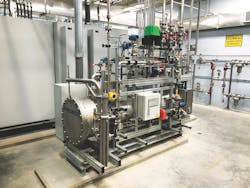Wedeco Ozonation Process Improves Taste & Quality of Surface Water Supply
Xylem, Inc.
www.xylem.com
When summer arrives in Falmouth, Massachusetts, so do the tourists. Beaches, boating, fresh seafood and other activities make it an idyllic vacation destination. But the influx of out-of-towners to this small Cape Cod town can multiply water demand by as much as five times. That means the water department needs to increase its output to service from 31,000 permanent residents to a summer population of up to 120,000 people.
Until recently, a pump station in use since 1898 provided most of Falmouth’s water supply. While the water that the station provided was safe, it wasn’t filtered. This could give the water an unpleasant taste, smell and cloudy appearance.
Since Long Pond water was unfiltered, it relied heavily on chlorine as a disinfectant. In 2014, a Massachusetts Department of Environmental Protection (MassDEP) mandate gave Falmouth the option to add another disinfectant to its existing water treatment process or build a new facility.
The existing Long Pond Water Treatment Plant did not use filtration to remove bacteria, organics and particulates, so the water entering the distribution system was an ongoing concern with: elevated turbidity and organics leading to seasonal color, taste and odor complaints; and elevated bacteria and elevated algae counts. In addition, the high doses of chlorine needed to maintain the disinfection residuals required for an unfiltered supply reacted with the organics in the raw water to form disinfection by-products, which did not meet new EPA and MassDEP standards.
As a result of the MassDEP mandate, the town voted to allocate $46 million to construct a new water treatment and filtration plant on the east shore of Long Pond.
Construction on the new plant began in April 2015. The plant, which became operational in October 2017, delivers approximately 70% of all the water that is used from the public water system in Falmouth. The facility treats the water in four separate processes: algae removal; ozonation to improve taste and odor; activated carbon filtration; and sodium-hypochlorite disinfection. The four-step ozone filtration system has a greater disinfection effectiveness against bacteria and viruses and has oxidizing properties that can help reduce the concentration of iron, manganese and sulfur.
The new plant, which handles an average of 8.4 million gallons per day, can adjust to accommodate fluctuating flow rates of 2.5 million gallons per day during the winter up to a peak of 12 million per day in the summer, when the tourist population swells.
Since the new plant went online in late 2017, it has significantly improved both the water supply’s taste and quality. And using the latest control and information technologies, the plant can be minimally staffed, helping keep operating costs and hiring demands down. The Long Pond WTP also uses Xylem’s annual Preventative Maintenance Agreement (PMA) to protect its ozone technology investment.
